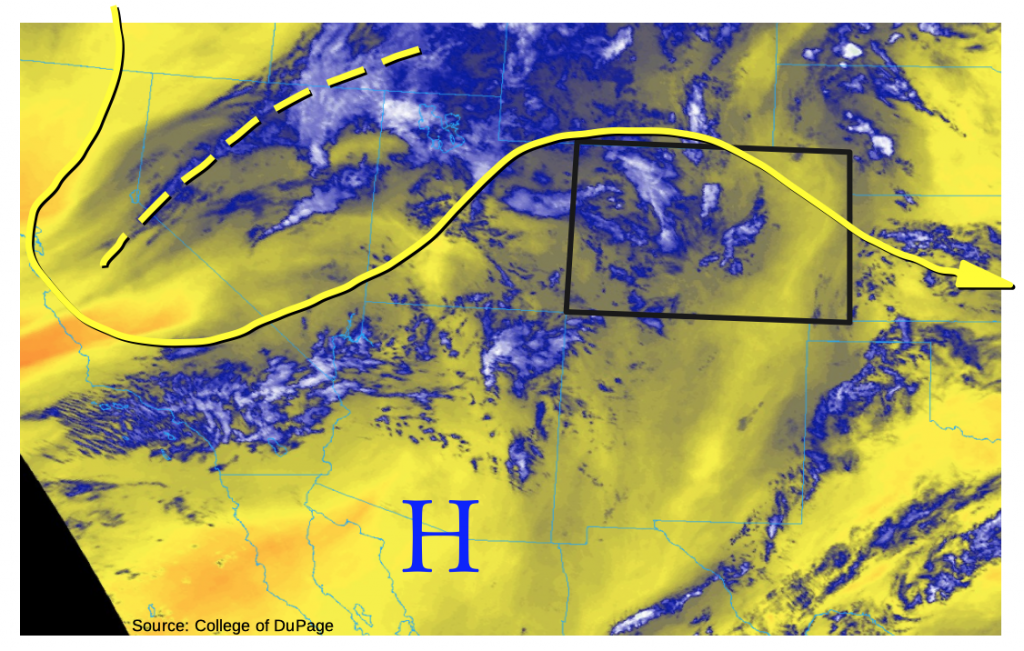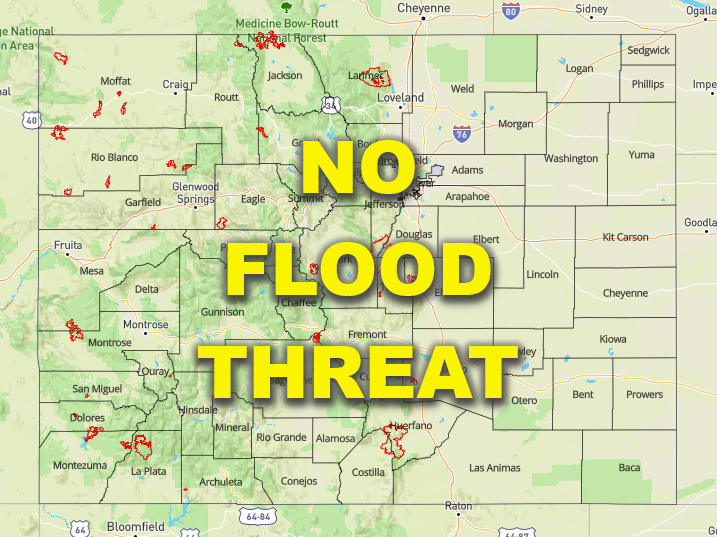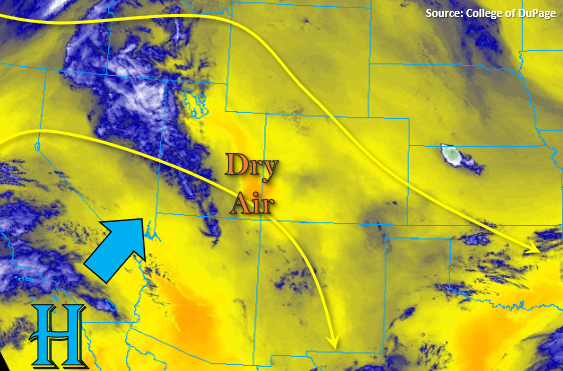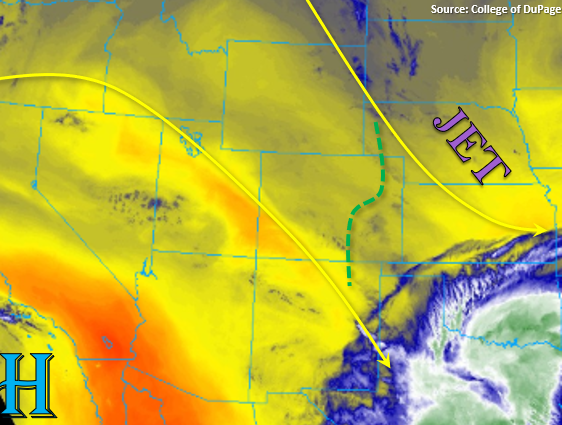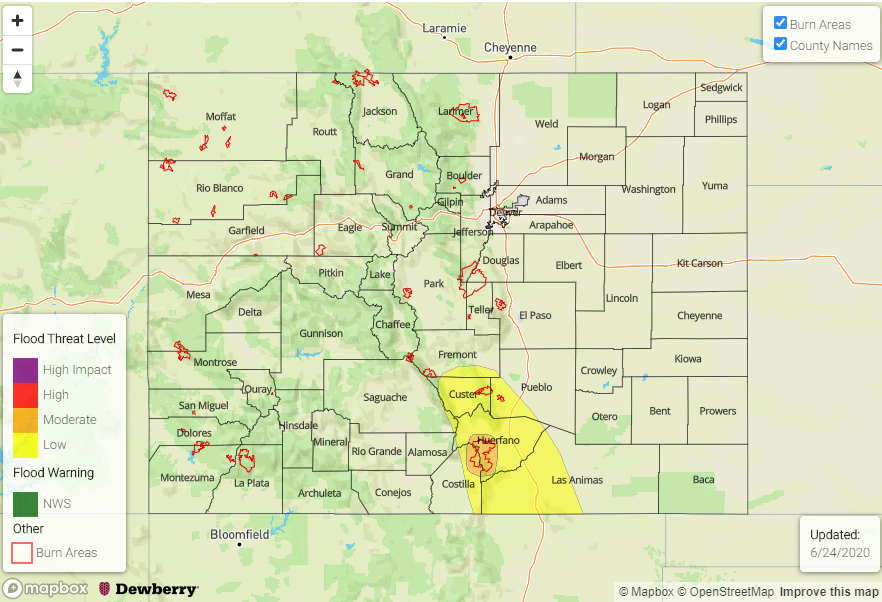Issue Date: Friday, June 26th, 2020
Issue Time: 9:35AM MDT
— A LOW flood threat has been issued for the Palmer Ridge and portions of the Urban Corridor, Northeast Plains, and Southeast Plains
It’s going to be an active rainfall day for the state with severe weather likely over eastern Colorado late this afternoon and evening. For the synoptic set up, some mid-level energy has broken off from the main flow and is sitting over California. This will allow vorticity to move through the state and enhance lift (coverage and strength of storms), which can be seen in the water vapor imagery below (orange “X”). As for moisture, a cold front moved through eastern Colorado last night, so the low levels look pretty moist in this area. The dew point at DIA this morning was 53F, and PW was measured at 0.86 inches. Over Grand Junction, it’s a bit drier with dew points in the mid-40Fs, but PW was measured at 0.70 inches (above climatology). There also looks to be a little better moisture over the northwest corner of the state associated with a shortwave moving through the area, which will help spark scattered storms this afternoon and evening.
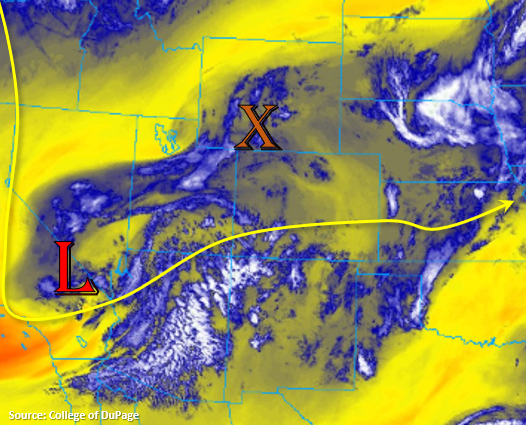
Moderate westerly flow aloft will likely mix out some of the surface moisture from west to east throughout the day, but widespread thunderstorm activity is still forecast. Storms over western Colorado will likely be confined to the higher terrains and favor the Central/Northern Mountains and Grand Valley/Northwest Slope where the shortwave moves through. Expecting storms to form over the eastern mountains by early afternoon as surface winds turn more easterly. Thunderstorms should push into the adjacent plains by 2 or 3PM. As they move east, outflow boundaries will likely trigger additional convection in a moisture rich environment, so storms will likely become a multi-cell cluster capable of producing large hail, local heavy rainfall, and damaging winds. A brief, weak tornado is also possible. Although storms will be moving at 15 to 20 mph (slightly to the southeast), they will still be capable of dropping local, heavy rainfall, so a Low flood threat has been issued. Thunderstorms should exit into Kansas and Nebraska just after midnight.
Today’s Flood Threat Map
For more information on today’s flood threat, see the map below. If there is a threat, hover over the threat areas for more details, and click on burn areas to learn more about them. For Zone-Specific forecasts, scroll below the threat map.
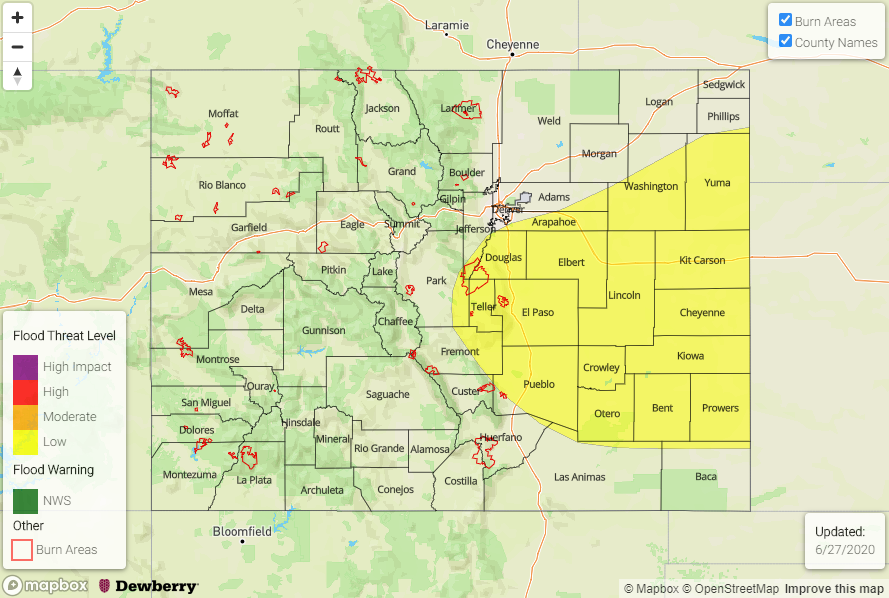
Zone-Specific Forecasts:
Front Range, Urban Corridor, Palmer Ridge, Southeast Plains, & Northeast Plains:
Storms will form a little sooner this afternoon and push into the adjacent plains by mid-afternoon. Activity will be widespread and more severe when compared to the last couple of days. Severe thunderstorms will be capable of producing strong winds, severe hail, and local heavy rainfall. As storms move east, the largest hazard becomes damaging wind, although some large hail will also still be possible. Cannot rule out a weak tornado as well. Max 1-hour rain rates up to 1.20 inches (west) will be possible (likely the Palmer Ridge) and up to 1.60 inches east. A Low flood threat has been issued for urban flooding (quick 0.50 inches in 30 min), field ponding, road flooding and local stream flooding. Storms will fully exit the state around midnight, so the flood threat ends a couple hours after sundown.
Primetime: 12:30PM to 12AM
Central Mountains, Northern Mountains, Northwest Slope, & Grand Valley:
Moisture has moved into the area from the passing shortwaves. Therefore, a little wetting rainfall is possible over the higher elevations in these regions. Scattered storms may produce max 1-hour rain rates up to 0.30 inches with slightly higher, localized totals in the Northern Mountains. Storms will also likely produce gusty outflow winds, so brief gusts up to 45 mph are also forecast. Flooding is not anticipated with the storms that form today.
Primetime: 1PM to 11PM
Southeast Mountains, San Juan Mountains, San Luis Valley, Southwest Slope & Raton Ridge:
It will be rather dry over these regions this afternoon with some scattered activity still forecast for the northern San Juan Mountains and Southeast Mountains. Additional storms may form along the elevated regions in Montrose and Mesa County as the shortwave moves through. Max 1-hour rain rates up to 0.15 inches will be possible. Today’s dry thunderstorms and gusty outflow winds will likely elevate the fire risk over these areas.
Primetime: 12:30PM to 9PM
